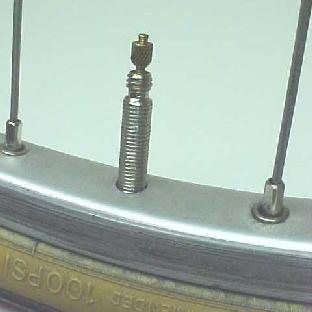
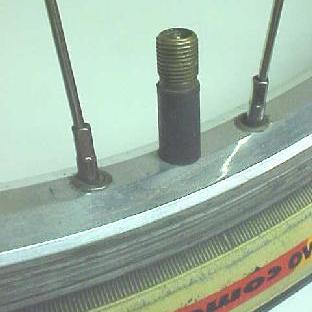


Left Presta, right Schrader. Presta valves are more often found on high performance bicycles with narrow rims and tires. Both types can be opened by depressing the narrow stem in the center. The Presta valve's stem can be locked in the closed position by screwing down the knurled nut at the top. The Schrader valve stem is recessed, lacks the locking nut and normally uses a spring to help keep it closed. The Schrader valve has a removable core; most Presta valves don't. Click here for a picture of a Presta valve with a removable core. There are some pictures of Schrader cores farther down on this page.
There is a common misconception that Presta valves are better for the higher pressures used in high performance bicycle tires, but Schrader valves are used in many high pressure industrial applications, as well as high pressure bicycle suspension systems.
You can use a Presta valve in a rim with a Schrader sized hole with a grommet or adapter. I've never tried that because I see no reason not to use a Schrader valve if it will fit..
Presta:
+ Smaller diameter requires a smaller hole in the rim, which for narrow rims can at least theoretically allow tighter spoking for a stronger wheel.
+ Better size to fit between tire beads on very narrow rims.
+ Exposed stem makes it easier to manually deflate the tube.
+ Can be locked to the rim with a locknut, which makes it a little easier to attach a pump before inflating. There used to be some fully threaded Schrader valves with this feature, but I haven't seen any lately. I prefer not to use locknuts in any case because they can stress the area where the valve is attached to the tube, and hide misalignment of the tube relative to the rim hole.
+ Slightly lighter and more aerodynamic?
- More fragile due to the smaller diameter and the exposed valve core stem.
- Easy to lose air pressure by accidentally touching the valve core stem with the pump head.
- Conical valve seat can tend to stick in the closed position. (I have had them stick in the open position too)
Schrader:
+ More universal valve type; easier to find pumps and pressure gauges that fit; can use gas station compressor hose in a pinch; tubes easier to find in places other than specialty bike shops. In a pinch I can use the same pump to inflate my suspension air shock and my tires.
+ More robust due to larger diameter and delicate parts being completely recessed.
+ Flat valve seat opens and closes more freely - especially if the spring is removed (see below).
- The spring in the valve can make it much more difficult to pump if the pump doesn't have a valve depressor pin. But all the Schrader pumps I've seen lately do come with the pin. However with the pin it becomes easy to lose pressure when detaching the pump.
These last objections can be eliminated by removing the spring from the Schrader valve core, and the depressor pin and check valve from the pump. But the pump can then no longer be used on unmodified valves.
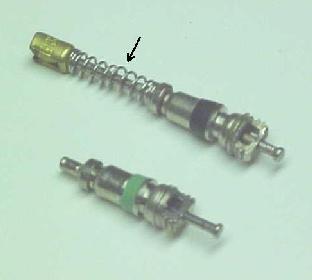 In the
photo to the left are two different types of Schrader valve
cores, a "long" core which has a relatively large
exposed spring, and a "short" one with an internal
spring that isn't visible.
In the
photo to the left are two different types of Schrader valve
cores, a "long" core which has a relatively large
exposed spring, and a "short" one with an internal
spring that isn't visible.
The spring is easily removed from the long core by simply cutting at the location of the arrow in the picture.
I know of no way to remove the concealed spring from the short core.
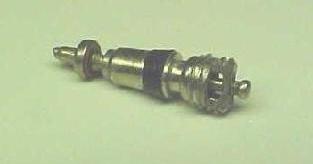 Here is a formerly long Schrader core which has had its
lower stem and spring cut off. Note that the valve is open. This
is the kind of core I use in all my Schrader valves.
Here is a formerly long Schrader core which has had its
lower stem and spring cut off. Note that the valve is open. This
is the kind of core I use in all my Schrader valves.
It seems that new Schrader tubes nowadays rarely come with a "long" core, but they are interchangeable, and the core should last many times longer than the tube itself.
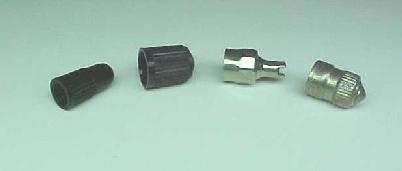 Here are four different
valve caps. From left to right, plastic Presta, plastic Schrader,
metal Schrader with valve core wrench, and metal Schrader with
valve core stem depressor. I use only the latter two types on my
bicycles with Schrader valves. The metal caps have a rubber
gasket that seals more reliably than the plastic ones. If you
can't find them at your bike shop, try a auto parts store.
Occasionally a Schrader valve may leak a little after the spring
is removed. This is not an issue if the valve cap makes a good
seal, but might be noticed when the cap is loosened. I do use the
plastic Schrader caps on spare tubes only, while the tube is not
being used.
Here are four different
valve caps. From left to right, plastic Presta, plastic Schrader,
metal Schrader with valve core wrench, and metal Schrader with
valve core stem depressor. I use only the latter two types on my
bicycles with Schrader valves. The metal caps have a rubber
gasket that seals more reliably than the plastic ones. If you
can't find them at your bike shop, try a auto parts store.
Occasionally a Schrader valve may leak a little after the spring
is removed. This is not an issue if the valve cap makes a good
seal, but might be noticed when the cap is loosened. I do use the
plastic Schrader caps on spare tubes only, while the tube is not
being used.
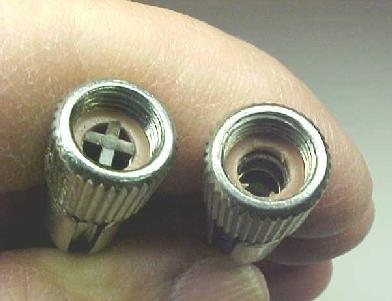 Thread-on pump
hose ends before and after removing the valve core depressor pin
and check valve. This was done by just gripping it with a needle
nose pliers and pulling it out. The check valve is just a tiny
rubber ball that's held captive behind the depressor. The method
for removing these parts varies with different kinds of pumps,
but I've never encountered one that I couldn't remove the pin
from, one way or another.
Thread-on pump
hose ends before and after removing the valve core depressor pin
and check valve. This was done by just gripping it with a needle
nose pliers and pulling it out. The check valve is just a tiny
rubber ball that's held captive behind the depressor. The method
for removing these parts varies with different kinds of pumps,
but I've never encountered one that I couldn't remove the pin
from, one way or another.
Some pumps, like my Topeak Mountain Morph, may have the check valve in the body of the pump instead of in the hose or head. In that case I didn't try to mess with the check valve.
For more about pumps, see my pump page.
December 3, 2002